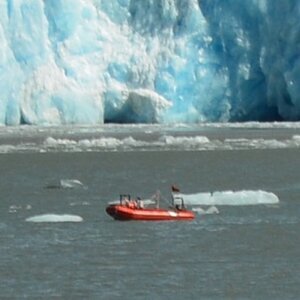
College of Engineering Unit:
At the College of Earth, Ocean, and Atmospheric Science, researchers study glaciers to measure the effects of climate change and glacial melt on the oceans. Glaciers can spontaneously collapse and are surrounded by other obstacles, making directly studying them too dangerous for manned vessels. Due to poor visibility and wireless connections, remotely-operated “drone boats” are infeasible for regular research. To solve these issues, we are designing and implementing a system which enables an unmanned research vessel to autonomously navigate the dangerous waters surrounding glaciers, enabling scientific research.
To detect objects surrounding the vessel, we turn to Light Detection and Ranging, or LIDAR. This is a technology that allows autonomous vehicles to measure the distance to objects around them using a laser. This laser spins rapidly, measuring the distance to every object in its surroundings and acts as our primary object detection. We remove noise and other bad data from the LIDAR system using a Kalman filter. Then, a k-D tree algorithm is used to detect clusters of points that represent objects. Future work for our object detection system will combine the LIDAR system with a pre-existing object recognition camera system, which allows the vessel to know what objects are where.
Based on the surround objects, we designed a pathfinding and control system. This system answers the question: given the surrounding objects, what is the safest and most efficient way for the vessel to get from point A to point B? To do so, we create and store a map of the surrounding area using data from our object detection system. Then, we use a modified A* pathfinding algorithm to choose the most efficient path to a GPS waypoint that is provided by the user. Future work will integrate our control system with the existing research vessel so we can begin testing our system in real life. This will enable the quick and safe navigation of the vessel to the edge of glaciers so scientific measurements can be taken.
| Attachment | Size |
|---|---|
| 1 MB |